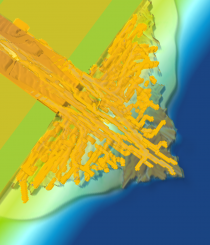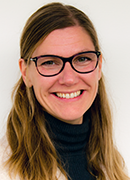Facies modeling in deltaic reservoirs - geological process models and MPS
Facies modeling in deltaic reservoirs - geological process models and MPS
The aim of this study is to investigate how numerical simulations of geological processes can be used to improve the reservoir models.
In this project we investigate how synthetic deposits generated by process-based models can be utilized in classical facies modeling workflows. Synthetic deposits are numerical analogues of geological deposits, generated by solving physical equations for sediment transport and fluid motion. We work in a shallow marine depositional setting, where a feeder channel delivers sediment to a basin with limited marine reworking under constant sea level. This leads to the development of prograding deltas with various geometries depending on input variables such as sediment properties, basin slope and hydrodynamics. We established a workflow to transfer the modelled data into the reservoir modeling framework, where we can extract information relevant for facies models.
The main focus has been on the Multipoint facies simulation algorithm, also known as SNESIM or MPS. This method requires training images representing the geological pattern to be simulated, and the key idea is that to use the output from the process models as input.
The synthetic delta models contain a lot of information, such as fluid velocities, sorting, grain size distribution and depositional history. However, they do not come with a discrete facies classification, and we have explored some solutions to this.
Once a classification is established, we use the facies pattern as training images in the SNESIM algorithm. We have extended the SNESIM algorithm to accept multiple training images to investigate the effect of using one versus multiple process-based models as input. Automated procedures have been developed to support this workflow. The results are evaluated based on a developed QC tool, which allows for visual and quantified pattern recognition.
Images

Publications
Aarnes, Ingrid; Fjellvoll, Bjørn and Hauge, Ragnar. Utilizing process-based models in facies modelling workflows. Report: SAND/08/2017.
Ingrid Aarnes, Bjørn Fjellvoll, Helena Van Der Vegt and Kjetil Nordahl. Using sedimentary process models to assist reservoir facies modeling. NPF Reservoir Characterization December 2017, Stavanger, Norway. Conference presentation.
Ingrid Aarnes, Bjørn Fjellvoll, Helena Van Der Vegt and Kjetil Nordahl. Traversing the gap from sedimentary process models to facies modeling. Gussow conference October 2019. Lake Lousie, Canada. Conference presentation.

Research areas
Project period
November 2016 - December 2017



 Hvordan komme til NR
Hvordan komme til NR Del på sosiale media
Del på sosiale media Personvernerklæring
Personvernerklæring